WORLD CLASS COACHING
40 Individual Defending and Small Group Exercises
By Luca Bertolini
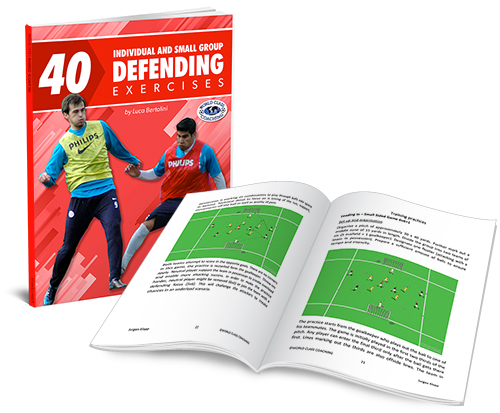
Table of Contents
PART THREE
2v2 Exercises
2v2+1 Exercises
2 v 2 Exercises
Exercise 26 - 2 v 2: mark the man on or track the opponent (1)
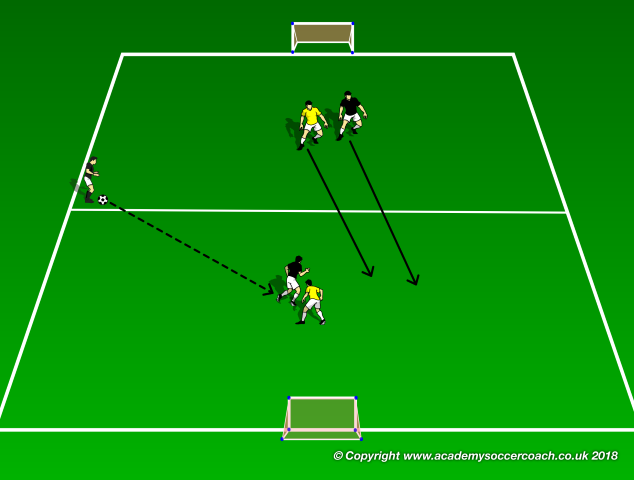
Set-up and Sequence: a rectangular space is divided into 2 areas as in the picture. A 1 v 1 duel is played inside each zone and the coach has the possession. 2 goals are placed along the end lines.
The coach decides the half of the pitch where to kick the ball; the defender, who is placed there, must mark the opponent on while receiving, to avoid him playing with the teammate, who's coming from the opposite half. The second defender must track the direct opponent; a 2 v 2 is now created inside one half.
If the defenders win the ball, they can counter attack toward the opposite goal; the players who lost the possession must counter-press immediately, as transition to defend, to prevent any counter attacks.
Eye on: pressure to prevent the forward from receiving, be placed between the forward and the goal space while tracking him back, pressure to recover the ball as soon as possible and counter-pressing to prevent transitions to attack of the new ball carriers.
Exercise 27 - 2 v 2: mark the man on or track the opponent (2)
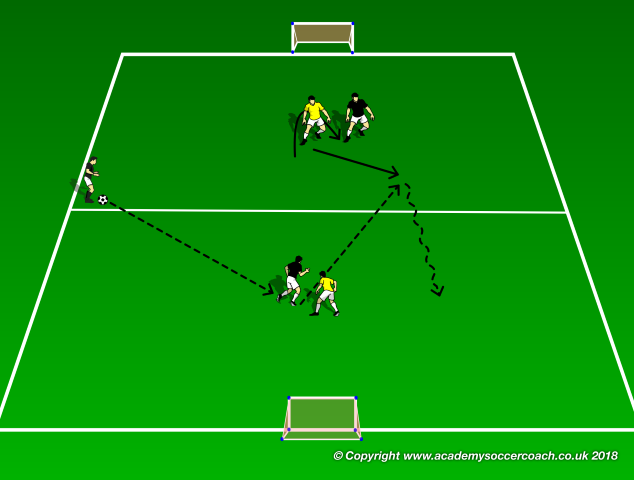
Set-up and Sequence: this practice is a variation of the previous exercise.
The coach decides the half of the pitch where to kick the ball; the defender, who is placed there, must mark the opponent on while receiving, to avoid him passing the ball back to the teammate on the other half, who could dribble to finish. The second defender must track the direct opponent, trying to anticipate him while receiving.
If the defenders win the ball, they can counter attack toward the opposite goal; the players who lost the possession must counter-press immediately, as transition to defend, to prevent any counter attacks.
Eye on: pressure to prevent the forward from receiving, be placed between the forward and the goal space while tracking him back, pressure to recover the ball as soon as possible and counter-pressing to prevent transitions to attack of the new ball carriers.
Exercise 28 - 2 v 2: pressure to avoid the opposition building up phase
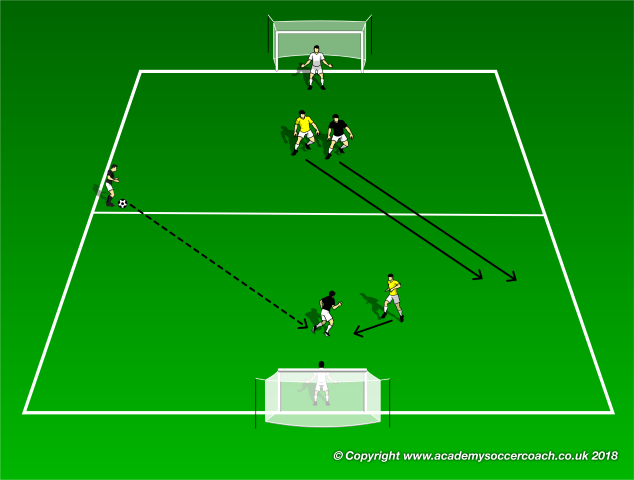
Set-up and Sequence: a rectangular space is divided into 2 areas, as in the picture. A 1 v 1 duel is played inside each zone and the coach has the possession. 2 goals with goalkeepers are placed along the end lines.
The coach decides the half of the pitch where to kick the ball; the defender, who is placed there, must put pressure on the opponent while receiving to prevent him from building up and from playing with a teammate, who's dropping back from the attacking half. The second defender must track the direct opponent to prevent him from receiving; a 2 v 2 is now created inside one half.
If the defenders win the ball, they can counter attack toward the goal of the pressure area; the players who lost the possession must counter-press immediately, as transition to defend, to prevent any finishing phase.
Eye on: pressure to prevent the forward from receiving and building up, track back to avoid support play, pressure to recover the ball as soon as possible and counter-pressing to prevent transitions to attack of the new ball carriers.
Exercise 29 - 2 v 2: pressure inside a strong side
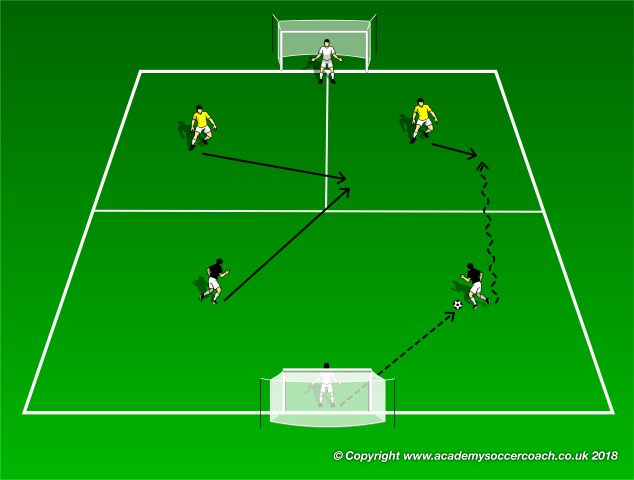
Set-up and Sequence: a rectangular space is divided into 3 areas, as in the picture. 2 goals with goalkeepers are placed along the end lines. A 2 v 2 duel is played inside the area; the attacking couple builds up from the back freely, but the players must choose one of the smaller finishing areas to shoot on goal (on the right in the picture). The defenders are placed inside each upper area to save the goal space at the beginning; as the attacking phase is being developed inside one of those zones, the first defender must try to counter the ball carrier, waiting for the support of the teammate, who must close the space to the incoming opponent. They should exchange the mark while shifting across if needed.
If the defenders win the ball, they can counter attack after a safe back pass to the goalkeeper; the players now in transition to defend must put pressure to avoid the attacking team (the yellow couple) from dribbling inside the main area, where they can finish freely.
Variation: create a strong side and finish/defend a weak side (the free smaller area during the building up phase)
Eye on: pressure on the strong side and to avoid the building up phase, patience to wait for defense support, recover the space to save the weak side.
Exercise 30 - 2 v 2: cover the overlap runs
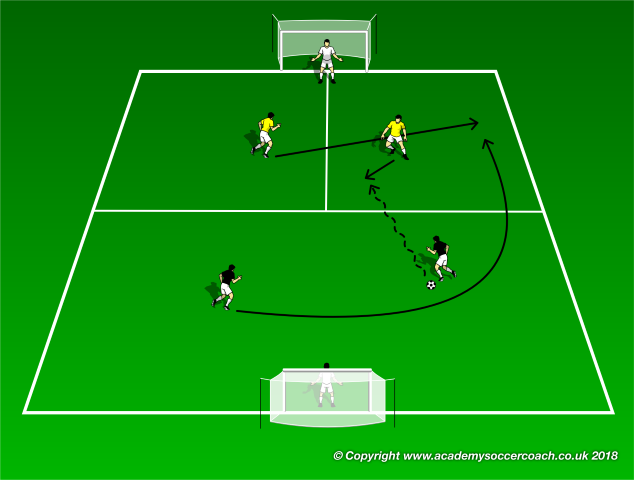
Set-up and Sequence: this practice is a variation of the previous one.
The couple of players in possession must finish inside one of the smaller upper areas and after an overlap run.
The defenders are again placed inside each upper area to save the goal space at the beginning; as the attacking phase is being developed inside one of those zones, the first defender must try to counter the ball carrier and to wait for the support of the teammate, who must close the space behind him to counter the overlap movement of the opponent. If the defenders win the ball, they can counter attack after a safe back pass to the goalkeeper; the players now in transition to defend must put pressure to avoid the attacking team (the yellow couple) from dribbling inside the main area, where they can finish freely.
Eye on: pressure on the strong side and to avoid the building up phase, patience to wait for defense support, recover the space to save the weak side.
2 v 2 + 1 Exercises
Exercise 31 - 2 v 2 + 1: manage the numerical disadvantage against a center forward
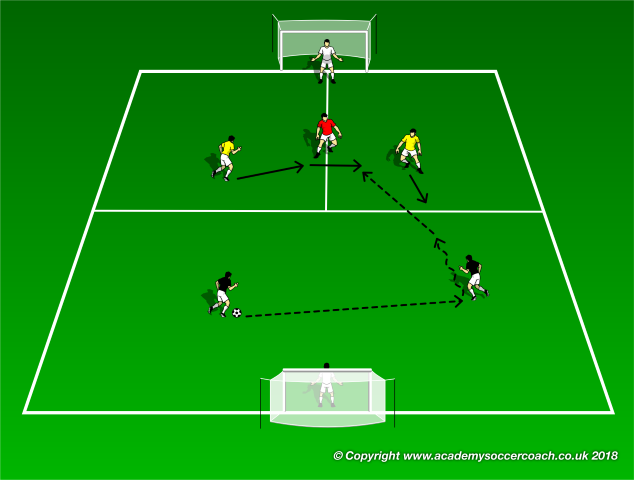
Set-up and Sequence: a rectangular space is divided into 3 areas, as in the picture. 2 goals with goalkeepers are placed along the end lines. A 2 v 2 duel is played inside the area; the attacking couple builds up from the back freely. The defenders are placed inside each upper area to save the goal space at the beginning. A fifth neutral field player is free to move between the upper areas, acting as center forward.
The defenders must create numerical advantage 2 v 1 against the center forward, while the attacking couple is building up from the back. As the red player receives, the defenders are outnumbered 2 v 3; it is very important to try to anticipate the forward immediately to avoid the outnumbered situation. If it's not possible, the defender must cover the goal space.
If the defenders win the ball, they can counter attack after a safe back pass to the goalkeeper; the players now in transition to defend must put pressure to avoid the attacking team (the yellow couple) from dribbling inside the main area, where they can finish freely. The free player becomes the first defender who must counter the possession phase of the new attacking team. A 3 v 3 duels is created during the transitions phase (attack / defend) and a 3 v 2 numerical advantage is created during the second defense phase.
Eye on: pressure and anticipation to win the ball, cover the space if outnumbered, force the possession phase backward with defensive numerical advantage.
Exercise 32 - 2 v 2 + 1: prevent the opponents from playing behind the defense line
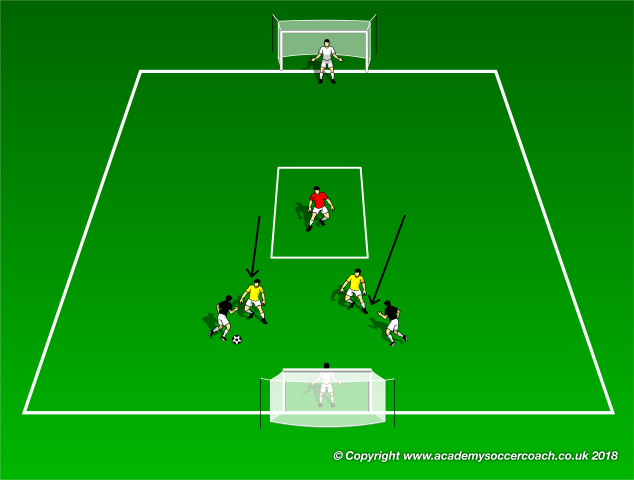
Set-up and Sequence: A 2 v 2 + 1 duel is played inside a rectangular space. 2 goals are placed along the shorter sides of the set-up. A fifth red neutral player is placed inside a center small rectangle where he is free to move and waiting to receive the ball. The couple with possession starts in front of the own goal to build up and the defending couple starts the exercise sideways the area in the middle.
As the first player of the attacking couple receives from the goalkeeper, both the defenders must run up over the middle area and put pressure to prevent the players in possession from passing at their back and toward the center free neutral player. If he receives, the attacking team can finish 3 v goalkeeper. If the defenders recover the possession, they can counter attack 2 v 2, or they can be helped by the neutral player, through a first safe pass, as transition to attack phase. The couple of players that lost the possession must counter press immediately as transition to defend.
Variation: both the goalkeepers are in possession, and the coach can decide the attacking and the defending couple time to time.
Eye on: pressure to close the passing lanes and to counter the transitions to attack phase of play.


